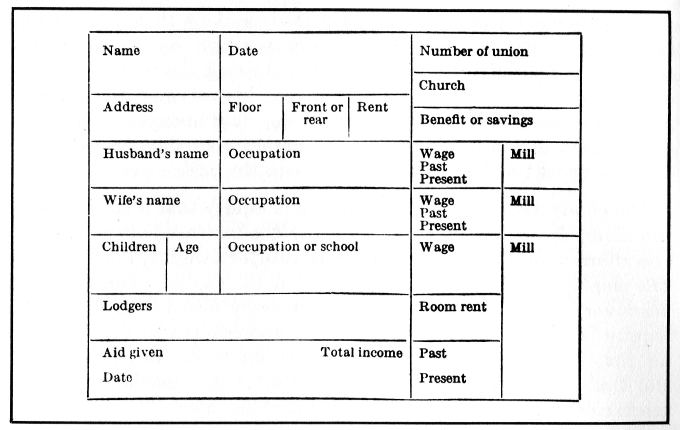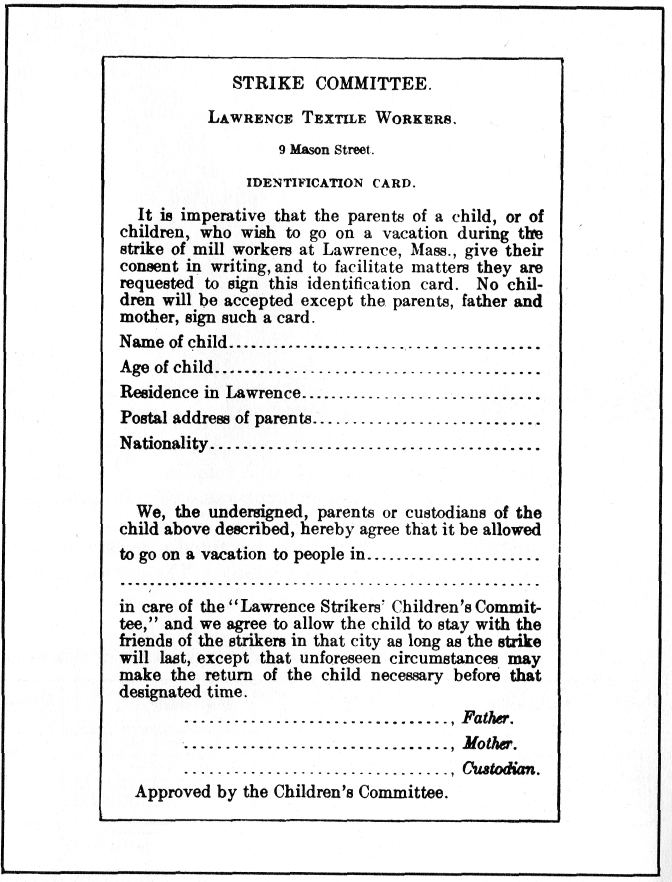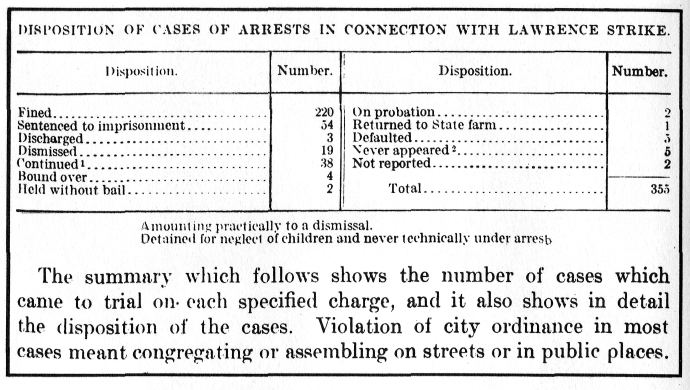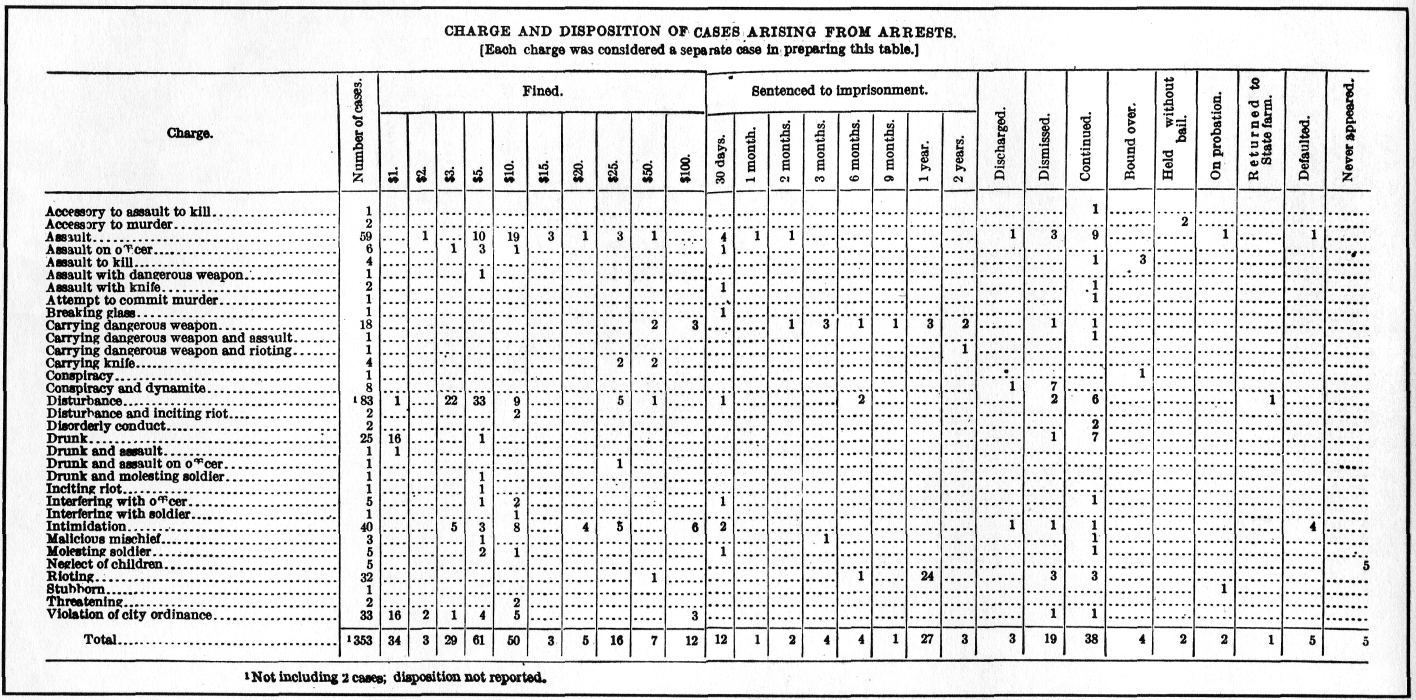
In all protracted strikes, and particularly in those of low-paid employees, destitution and suffering are inevitable accompaniments. Where a strike is conducted under the auspices of an organization well established and experienced in the conduct of strikes, and with ready facilities for furnishing strike benefits, the suffering and destitution may be reduced to a minimum, but the problem presented in Lawrence in the beginning seemed an appalling one. Some 23,000 employees had gone out on strike, and of these not over 2,800 belonged to organizations and were thus in position to be supported financially The remaining 20,000 had simply thrown up their employment without having in view any organized method of securing financial assitance. It is probably a conservative estimate to say that the number of nonwage earners in the families of those on strike added to the number who had left their employment comprised a total of some 50,000, out of a total population in Lawrence of approximately 85,000, who were without employment or any source of income.
Such a condition might well be expected to overwhelm the reliefgiving facilities of any community and justify a prediction that such a strike could not possibly continue more than a few days. The continuatice of the strike and its ultimate success was unquestionably due to the rapidity and the success with which those in charge of the strike of the unorganized employees devised and maintained a relief system. The relief problem facing the older organizations, composed of skilled employees and affiliated with the Central Labor Union, was comparatively simple. These organizations represented the betterpaid class of employees to begin with, and had regular established systems for furnishing relief during strikes. The Women's Trade Union League of Boston offered to cooperate with the Central Labor Union in furnishing relief to textile workers in need of relief because of the strike, and the Central Labor Union of Lawrence, at its regular meeting on January 28, voted to open headquarters there in cooperation with the Women's Trade Union League, and a committee was appointed to take this matter up.
Under its auspices, a relief station was established at the headquarters of the Central Labor Union. Milk and bread, and also shoes and other articles of clothing, were distributed directly to applicants from this relief station. A record was made of each applicant and the membership of the family wherever assistance (other than milk) was requested. A sufficient investigation was made to determine the need of such applicants for aid, and the information gathered was assembled on a card containing the following items:

Regular days were fixed for the distribution of relief, separate days being assigned to the English and non-English speaking applicants. As each applicant presented himself his card was looked up and such relief was granted as the conditions indicated by the card suggested. For supplies other than bread and milk and shoes and some articles of clothing, applicants were furnished with orders on certain stores, with which arrangements had been made to furnish supplies on the presentation of properly executed orders. In addition to furnishing food and other supplies, the Woman's Trade Union League maintained a trained nurse, whose time was given to assisting families in which there was sickness.
Although in the beginning the great majority of the strikers were unorganized, and comparatively few of them were affiliated with the Industrial Workers of the World, an official of that organization was requested by wire to come to Lawrence, and arrived there the second day of the strike. Within 48 hours after his arrival a committee had been organized known as the "strike committee," of which he was the chairman. This committee was placed in charge of the strike as far as it concerned some twenty thousand of the striking employees, both those who were unorganized and those affiliated with the Industrial Workers of the World. Although the chairman of the strike committee from the beginning to the end of the strike was an official of the Industrial Workers of the World, only a part of the membership of the committee was affiliated with that organization.
This "strike committee" promptly sent out an appeal for funds to labor organizations throughout the country, and from the beginning to the end of the strike contributions were received from regular trades-unions, from industrial unions, from socialistic organizations other than labor organizations, and from private sources. These relief funds came from all sections of the country, and averaged about $1,000 a day throughout the strike. On a few days the amount received by the strike committee exceeded $3,000. The "strike conimittee" promptly organized an elaborate relief system,-placing it under the control of a relief committee of 24 members; 6 of these formed the central committee and 18 conducted the investigations necessary to determine whether the applicants for relief were strikers in need of assistance. Eleven races or nationalities were represented on this committee of 24, as follows: Armenian, English, French, Franco-Belgian, French-Canadian, German, Irish, Italian, Lettish, Polish, and Syrian.
In addition to this general relief committee each of the principal nationalities had its own relief committee working in connection with this general committee.
The relief committee provided soup kitchens for men without families, and in some cases these soup kitchens were also patronized by women, but almost without exception families and women were supplied with food in their homes or furnished orders for groceries on some one of a number of stores.
The Industrial Workers of the World provided a weekly allowance for food based on the number in each family. The allowance was as follows:

In addition to the food, each family was allowed one dollar's worth of coal and fifty cents' worth of wood every second week, and in specially needy cases this amount was increased. Orders for shoes were also given, and two doctors gave medical assistance upon orders from the Industrial 'Workers of the World. In a few cases where peculiar hardship would result rent was paid by the relief committee, but in practically every case the rent was simply allowed to remain unpaid, and in the very few cases where tenants were compelled to vacate property, some landlord was found who would allow a tenement to be used rent free until the strike was over.
The relief committee investigated the cases of applicants for help to determine whether or not they were strikers, although the investigation was largely omitted in the case of the Italians, of which race practically every one employed in the textile mills was on strike. A 1)00k record was kept of all "scabs" (persons working during the strike), and any one working on another man's job was designated as "double scab." No assistance of any kind would be given to a ''scab."
Different methods of recording applicants for help were used by the various nationalities. The one used at the Franco-Belgian Hall showed the name, address, number in family, and opposite each date on which help was given the kind and amount of assistance given. From that hall relief was furnished some 1,200 families.
Some of the races numerically important had one or more stores from which supplies were distributed, while others secured their help through general headquarters at the Franco-Belgian Hall.
The Italians maintained four distributing stations, each furnishing relief to a more or less distinct district. Somewhat different methods of distributing supplies and checking the families were followed in the different stations. From one of these stations over 1,000 families were assisted. On Mardi 8 the number of families given food from that station was 552. The records in that store were simple but com- prehensive. Each family applying for aid was given a number. One book, which they called the "record book," was ruled in columns; the first column was for the book or, family number, the second for the name of the family, the third for the number of persons in the family, and at the top of the several remaining columns was written the name of the streets in that vicinity or district. When a family applied for aid the record was entered on a line in the "record book," first the number assigned to the family, the name of the family, the number of persons in the family, and in the appropriate street column the num- ber of the house.
The second book used was simply a day book ruled with columns. At the top of the first column was the family number, and at the top of the others was entered the articles of food usually distributed. On each day as assistance was given, the family number was entered, and on the same line was entered in the appropriate column the quantity of each article furnished the family. For instance, the day book showed that family No. 52 was supplied with 2 pork, 2 bread, 1 tomato sauce, 3 rice, and 3 potatoes; this means 2 pounds of pork, 2 loaves of bread (each loaf weighing about 2.5 pounds), 1 can of tomato sauce, 3 pounds of rice, and 3 pounds of potatoes. Family No. 1021 was furnished 2 pork, 2 tomato sauce, 3 rice, 4 potatoes, and 1 sugar. A reference to the "record book" shows that family No. 52 consisted of two persons, and family No. 1021 of seven persons.
Two soup kitchens were maintained by the Italians, one by the Syrians, one by the Polish, one by the Armenians, and one at the Franco-Belgian hail for all nationalities not provided for elsewhere. Various plans were followed in checking up those who patronized the soup houses in order to exclude "scabs" and to serve only strikers or members of their families. The Franco-Belgian soup kitchen fed about 1,300 persons twice a day during the strike. Meals for two typical days were as follows: On the first day the, morning meal consisted of bread, pressed ham, and tea; the afternoon meal was bread, beef, potatoes, peas, and tea. On the second day the morning meal was bread, potted meat, and tea, and the afternoon meal was bread, beef, potatoes, carrots, turnips, and tea. Everyone was served in abundance, and milk and sugar were provided for the tea. Women of the families of the strikers prepared the food in the soup kitchen and the men assisted in serving at the long tables.
In the other soup houses food desired by the particular nationality was served in abundance. In the Syrian soup kitchen women of the strikers' families assisted in preparing the food, while in the Italian soup kitchen such work was done by the men. The Syrian soup kitchen fed from 140 to 150 twice a day. On a typical day one of the meals consisted of bread, iamb, crushed wheat, specially prepared sour milk, and coffee; another meal of bread, rice, lima beans, and coffee. One of the Italian soup kitchens fed about 300 twice a day and the other Italian kitchen a larger number.
In addition to the relief furnished by organizations of the strikers, a relief station was maintained by social workers from outside of Lawrence out of funds contributed largely by outside sources, which supplied a few hundred children three times a day with cocoa and sandwiches and on some occasions with soup.
In spite of the large amounts received from outside sources and distributed through the relief system of the labor organizations, there was a heavy burden laid upon all the religious and civic charitable organizations of the city and upon private sources of charity during the entire period of the strike, and these organizations exerted every effort to meet the situation and furnished a large amount of relief.
The Identification Card and Consent Form Used for the Childrens Removal

During the period from January 12 to March 13, inclusive, the number of arrests arising from the Lawrence strike was 296. This number includes the 5 detained for neglect of children'' on February 24 these persons were never technically under arrest. More than 291; arrests were made during the period indicated above, but only 296 attests were of strikers, or persons connected with the strike, or in any way grew out of the strike, in many instances when a person was arrested more than one charge was placed against him, and when the matter cane before the court the charges were disposed of separately: thus one, of the persons arrested on January 15 was charged with rioting and also with carrying a dangerous weapon; on the first charge lie was sentenced to one year's imprisonment and on the second charge to six months' imprisonment.
Three hundred and fifty-five cases grew out of the 296 arrests, and they were disposed as follows:

